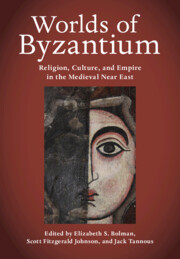Book contents
- Worlds of Byzantium
- Worlds of Byzantium
- Copyright page
- Contents
- Figures
- Tables
- Contributors
- Preface
- One Worlds of Byzantium
- I Patterns, Paradigms, Scholarship
- II Images, Objects, Archaeology
- III Languages, Confessions, Empire
- Thirteen Byzantine Syriac
- Fourteen Greek Identity in the Sinai
- Fifteen Patriarchs, Caliphs, Monks, Scribes, and the Byzantinization of Jerusalem’s Liturgy
- Sixteen Byzantine Judaism in Early Islamic Palestine
- Seventeen Ethiopia
- Eighteen Armenia and Byzantium
- Nineteen Byzantine Georgia/Georgian Byzantium
- Twenty Conclusion
- Index
- References
Twenty - Conclusion
Ends and Means
from III - Languages, Confessions, Empire
Published online by Cambridge University Press: 18 October 2024
- Worlds of Byzantium
- Worlds of Byzantium
- Copyright page
- Contents
- Figures
- Tables
- Contributors
- Preface
- One Worlds of Byzantium
- I Patterns, Paradigms, Scholarship
- II Images, Objects, Archaeology
- III Languages, Confessions, Empire
- Thirteen Byzantine Syriac
- Fourteen Greek Identity in the Sinai
- Fifteen Patriarchs, Caliphs, Monks, Scribes, and the Byzantinization of Jerusalem’s Liturgy
- Sixteen Byzantine Judaism in Early Islamic Palestine
- Seventeen Ethiopia
- Eighteen Armenia and Byzantium
- Nineteen Byzantine Georgia/Georgian Byzantium
- Twenty Conclusion
- Index
- References
Summary
The Conclusion raises the question of how the study of the literature and visual cultural of non-Greek-speaking, non-Constantinopolitan communities in the East Roman empire should relate to Byzantine studies. It further asks how the literature and visual culture of these communities should be seen as relating to Byzantine studies after these communities came under Muslim political control. A cultural, “Big Tent,” understanding of Byzantium is advocated for, one which de-privileges the state and which recognizes the importance of Christianity and its literary and visual manifestations for defining Byzantium as an object of study. This exapanded view of Byzantium includes in Byzantine studies the broader eastern Mediterranean world, Greek-speaking and non-, Chalcedonian and non-, Christian and non-.
Keywords
- Type
- Chapter
- Information
- Worlds of ByzantiumReligion, Culture, and Empire in the Medieval Near East, pp. 650 - 678Publisher: Cambridge University PressPrint publication year: 2024

